Nutella is among the most popular sweet-tasting condiments in the world.
It pairs well with many different foods, and most people enjoy its flavor. Additionally, with ingredients like cocoa and hazelnuts, some may wonder whether Nutella provides a good source of nutrients.
So, what does this chocolate-hazelnut spread offer nutritionally?
What ingredients does it contain? Is it merely a sweet spread to limit, or can it be considered a nutrient-rich choice?
Let’s find out.
Table of contents
What Is Nutella?

Nutella was first invented in the Piedmont region of Italy in 1946, with the original product sold in a loaf-shaped package. However, the first easily spreadable form of Nutella sold in a jar did not appear until 1964 (1).
It has always been a spread with a flavor based on a combination of three ingredients: sugar, cocoa, and hazelnuts. Nevertheless, these are not the only ingredients Nutella contains, as we will soon examine.
Among its many uses, Nutella is typically enjoyed as a spread on foods such as toast, pancakes, and crêpes.
The Nutella brand is owned by Ferrero, a large multinational Italian company specializing in chocolate and confectionery products (2).
Key Point: Nutella is a chocolate-hazelnut-flavored sweet spread commonly used as a condiment on dessert-style foods.
Ingredients Profile: What’s In It?
Although most people know that Nutella contains sugar, cocoa, and hazelnuts, its ingredient list is slightly more complex.
In fact, two additional ingredients appear in significantly higher quantities than cocoa and hazelnuts.
If you’re wondering exactly what Nutella contains, here is the full ingredients list, as provided by Ferrero on the U.S. version of Nutella (3):
- Sugar
- Palm oil
- Hazelnuts (13%)
- Skim milk powder (8.7%)
- Cocoa (7.4%)
- Soy lecithin
- Vanillin
While the precise amounts of sugar and palm oil are not listed, we can roughly estimate them based on the other ingredients.
Firstly, Nutella is 29.1% hazelnuts, skim milk powder, and cocoa by weight.
Soy lecithin, an emulsifier, and vanillin, an artificial flavoring, are typically used in extremely low quantities. Therefore, we can infer that Nutella is approximately 70% sugar and palm oil by weight.
Key Point: While Nutella is well-known for its cocoa and hazelnut content, its primary ingredients are sugar and palm oil.
What Nutrients Does Nutella Provide?
Based on USDA data, here are the nutrients present in a 37-gram, two-tablespoon serving of Nutella (4):
Calories and Macronutrients
- Calories: 200 kcal
- Carbohydrates: 22.0 g (8% of the daily value (DV))
- Fiber: 1.0 g (4% DV)
- Sugars: 21.0 g
- Fat: 11.0g (14% DV)
- Saturated fat: 4.0g (20% DV)
- Protein: 2.0g (4% DV)
Vitamins and Minerals
- Calcium: 40 mg (4% DV)
- Iron: 1.0 mg (6% DV)
- Potassium: 170 mg (4% DV)
- Sodium: 15.2 mg (1% DV)
Although this is the extent of the data provided in the USDA database, it is likely that other vitamins and minerals are present in small quantities due to Nutella’s ingredients profile.
For example, since cocoa is extremely rich in minerals like copper and magnesium, a serving of Nutella, which is 7.4% cocoa, will contain small amounts of these nutrients (5).
Likewise, hazelnuts, which constitute 13% of the ingredients in Nutella, provide a good amount of vitamin E (6).
Key Point: Nutella is primarily high in sugar and fat, with a small amount of protein. It also contains several vitamins and minerals, such as calcium and iron, in low quantities.
Potential Benefits and Downsides
There are no scientific studies that have specifically examined the health effects of Nutella. Therefore, we can only assess the product based on its ingredients and nutritional profile.
In this regard, let’s take a look at the potential benefits and drawbacks of Nutella.
Benefits
Contains Cocoa and Hazelnuts
Nutella is 13% hazelnuts and 7.4% cocoa by weight. These ingredients provide fiber, a range of vitamins and minerals, and are known for their high phytonutrient (specifically polyphenol) content—chemicals found in plant foods that can have health benefits (5, 6, 7, 8).
Energy Boost
Since Nutella contains high levels of fat, sugar, and calories, it provides a significant amount of energy.
For individuals specifically seeking to gain weight, high-energy foods can sometimes be useful for those who are struggling.
However, there are certainly healthier high-energy foods available for this purpose.
Key point: Nutella’s benefits revolve around its small provision of essential nutrients and its potential as an energy-dense ingredient.
Drawbacks
High in Sugar
A 37-gram, two-tablespoon serving of Nutella provides 21 grams of sugar. This is roughly equal to five teaspoons of sugar per serving.
According to an umbrella review of 73 meta-analyses on sugar intake and health outcomes published in 2023, high dietary sugar consumption increases the risk of increased body weight and poor health outcomes (9).
The researchers behind this review recommended reducing sugar intake to less than 25 grams per day (9).
The Dietary Guidelines for Americans, 2020-2025, recommend that people consume no more than 10% of calories from added sugar. Based on a 2000-calorie diet, this would be 200 calories, which is approximately 50 grams of sugar (10).
A Rich Source of Palm Oil, Which Can Raise LDL-C
Alongside sugar, palm oil is the other most concentrated ingredient in Nutella.
Palm oil is the oil of fruit that grows on palm trees, and it is high in saturated fat—specifically a saturated fatty acid called palmitic acid (11).
Two systematic reviews have demonstrated that palmitic acid is associated with increasing LDL cholesterol (low-density lipoprotein cholesterol) levels. To be specific, palmitic acid increased LDL-C more than unsaturated fatty acids and by a higher margin than another saturated fatty acid called stearic acid (12, 13).
Elevated levels of LDL-C are strongly associated with an increased risk of developing cardiovascular disease (14).
Studies specifically on palm oil appear to confirm these LDL-C-elevating effects. For instance, a 2015 meta-analysis of clinical trials found that palm oil consumption increased LDL cholesterol levels compared to low-saturated-fat vegetable oils (15).
Nutella Is Hyper-Palatable and Easy To Over-Consume
Due to its high-sugar, high-fat, and high-calorie content, Nutella can be easy to over-consume.
This is because it packs a lot of energy into a small serving, it tastes good, and it isn’t particularly filling. When foods have these three characteristics, it can be easier to eat more than you intended.
Additionally, some people may not stick to the recommended serving size of two tablespoons. In this regard, four tablespoons of Nutella would double the calorie intake to 400 calories, and that’s before we even consider the food that Nutella is being spread on.
As a result, when consuming Nutella, it is important to try and measure out the recommended serving size.
According to research, hyper-palatable foods feature specific combinations of fat, carbohydrates, sugar, and sodium that can interact with the brain’s reward system. This interaction influences eating behavior and encourages the desire to eat more food.
Nutella meets the following definition of being a hyperpalatable food by containing more than 20% of calories from fat and more than 20% of calories from sugar: “>20% kcal from fat, >20% kcal from sugar” (16).
Key Point: Nutella is an energy-dense and hyper-palatable food product that can be easy to over-consume.
Food Pairings To Enhance the Nutritional Value of Nutella
Nutella is primarily a source of fat and refined sugars, but we can make food featuring Nutella more nutritionally complete by considering what we pair it with.
For example, instead of spreading Nutella on white bread or pancakes, we could pair it with these options:
- Nutella and Mixed Berry Wholegrain Tortilla: Combining Nutella with berries adds essential nutrients like vitamin C, while the wholegrain tortilla provides more fiber and protein than refined bread options.
- Nutella Oatmeal With Pumpkin Seeds: Oatmeal offers high levels of fiber, protein, and several essential minerals, while pumpkin seeds add one of the best dietary sources of magnesium, healthy unsaturated fats, and some fiber and protein.
- Boiled Eggs With Nutella-Topped Rye Crackers and Fruit: Combining Nutella with a breakfast plate featuring boiled eggs, rye crackers, and fresh fruit provides the fiber, protein, and essential micronutrients that Nutella lacks.
- Greek Yogurt, Berry, and Nutella Pancakes: Adding some Greek yogurt and berries to Nutella pancakes enhances their provision of protein, fiber, and essential micronutrients like calcium and vitamin C.
Key Point: While Nutella isn’t particularly nutritious, we can enhance the nutrient provision of Nutella-based foods by focusing on nutrient-rich food pairings.
Can Nutella Be a Healthy Choice?
To be direct, Nutella is not a significant source of beneficial nutrients and mainly supplies sugar and palm oil. Added to the fact that it is very energy-dense and easy to over-consume, there are not many nutritional reasons to consume Nutella.
This doesn’t mean that Nutella can’t be enjoyed from time to time by those who like it, as is it is our habitual diet that matters most for health.
However, it should be consumed with the knowledge that there are better alternatives nutritionally, and it should be an occasional treat rather than a regular part of the diet.
For some healthier spread options, see this nutritional guide to nut butters or explore this in-depth look at hummus.








